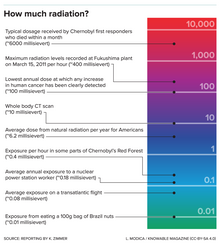
Back የ2003 ዓ.ም. ፉኩሺማ አደጋ ውጤት Amharic Strahlungsbelastung durch die Nuklearunfälle von Fukushima German Conséquences environnementales et sanitaires de l'accident de Fukushima French 福島第一原子力発電所事故の影響 Japanese Fukusima-Daichi yadroviy halokatining radiatsiya taʼsiri Uzbek 福島第一核電廠事故的輻射影響 Chinese
This article has multiple issues. Please help improve it or discuss these issues on the talk page. (Learn how and when to remove these template messages)
|







The radiation effects from the Fukushima Daiichi nuclear disaster are the observed and predicted effects as a result of the release of radioactive isotopes from the Fukushima Daiichii Nuclear Power Plant following the 2011 Tōhoku 9.0 magnitude earthquake and tsunami (Great East Japan Earthquake and the resultant tsunami).[3][4] The release of radioactive isotopes from reactor containment vessels was a result of venting in order to reduce gaseous pressure, and the discharge of coolant water into the sea.[5] This resulted in Japanese authorities implementing a 30-km exclusion zone around the power plant and the continued displacement of approximately 156,000 people as of early 2013.[4][6] The number of evacuees has declined to 49,492 as of March 2018.[7] Radioactive particles from the incident, including iodine-131 and caesium-134/137, have since been detected at atmospheric radionuclide sampling stations around the world, including in California and the Pacific Ocean.[8][9][10]
The World Health Organization (WHO) released a report that estimates an increase in risk for specific cancers for certain subsets of the population inside the Fukushima Prefecture. A 2013 WHO report predicts that for populations living in the most affected areas there is a 70% higher risk of developing thyroid cancer for girls exposed as infants (the risk has risen from a lifetime risk of 0.75% to 1.25%), a 7% higher risk of leukemia in males exposed as infants, a 6% higher risk of breast cancer in females exposed as infants and a 4% higher risk, overall, of developing solid cancers for females.[11][12]
Preliminary dose-estimation reports by WHO and the United Nations Scientific Committee on the Effects of Atomic Radiation (UNSCEAR) indicate that, outside the geographical areas most affected by radiation, even in locations within Fukushima prefecture, the predicted risks remain low and no observable increases in cancer above natural variation in baseline rates are anticipated.[13] In comparison, after the Chernobyl reactor accident, only 0.1% of the 110,000 cleanup workers surveyed have so far developed leukemia, although not all cases resulted from the accident.[14][15][16] However, 167 Fukushima plant workers received radiation doses that slightly elevate their risk of developing cancer.[15][17][18] Estimated effective doses from the accident outside of Japan are considered to be below, or far below the dose levels regarded as very small by the international radiological protection community.[19] The United Nations Scientific Committee on the Effects of Atomic Radiation is expected to release a final report on the effects of radiation exposure from the accident by the end of 2013.[18]
A June 2012 Stanford University study estimated, using a linear no-threshold model, that the radioactivity release from the Fukushima Daiichi nuclear plant could cause 130 deaths from cancer globally (the lower bound for the estimate being 15 and the upper bound 1100) and 199 cancer cases in total (the lower bound being 24 and the upper bound 1800), most of which are estimated to occur in Japan. Radiation exposure to workers at the plant was projected to result in 2 to 12 deaths.[20] However, a December 2012 UNSCEAR statement to the Fukushima Ministerial Conference on Nuclear Safety advised that "because of the great uncertainties in risk estimates at very low doses, UNSCEAR does not recommend multiplying very low doses by large numbers of individuals to estimate numbers of radiation-induced health effects within a population exposed to incremental doses at levels equivalent to or lower than natural background levels."[21]
- ^ Cite error: The named reference
Japan anti-nuclear protesters rally after PM call to close plantwas invoked but never defined (see the help page). - ^ Kumagai, Atsushi; Tanigawa, Koichi (2018). "Current Status of the Fukushima Health Management Survey". Radiation Protection Dosimetry. 182 (1): 31–39. doi:10.1093/rpd/ncy138. PMC 6280984. PMID 30169872.
- ^ a b Maeda, Masaharu; Oe, Misari; Bromet, Evelyn; Yasumura, Seiji; Ohto, Hitoshi (2016). "Fukushima, mental health and suicide". Journal of Epidemiology and Community Health. 70 (9): 843–844. doi:10.1136/jech-2015-207086. PMID 26962203. S2CID 31302204.
- ^ Sato, Akiko (2018). "Diversity of Concerns in Recovery after a Nuclear Accident: A Perspective from Fukushima". International Journal of Environmental Research and Public Health. 15 (2): 350. doi:10.3390/ijerph15020350. PMC 5858419. PMID 29462905.
- ^ Cite error: The named reference
Fukushima: Fallout of fearwas invoked but never defined (see the help page). - ^ "Transition of evacuation designated zones - Fukushima Revitalization Information Portal Website". www.pref.fukushima.lg.jp. Retrieved 9 November 2023.
- ^ Cite error: The named reference
newscientist.comwas invoked but never defined (see the help page). - ^ Cite error: The named reference
usatodaywas invoked but never defined (see the help page). - ^ Cite error: The named reference
seattletimes.nwsource.comwas invoked but never defined (see the help page). - ^ Cite error: The named reference
reuterswas invoked but never defined (see the help page). - ^ Cite error: The named reference
Walsh 2013was invoked but never defined (see the help page). - ^ WHO 2013, p. 8.
- ^ Cite error: The named reference
Zablotskawas invoked but never defined (see the help page). - ^ a b Cite error: The named reference
Brumfielwas invoked but never defined (see the help page). - ^ Cite error: The named reference
Cardis et al. 2006was invoked but never defined (see the help page). - ^ Cite error: The named reference
who.intwas invoked but never defined (see the help page). - ^ a b Cite error: The named reference
unis.unvienna.orgwas invoked but never defined (see the help page). - ^ Cite error: The named reference
who42was invoked but never defined (see the help page). - ^ Cite error: The named reference
stanfordwas invoked but never defined (see the help page). - ^ Cite error: The named reference
UNSCEAR statementwas invoked but never defined (see the help page).